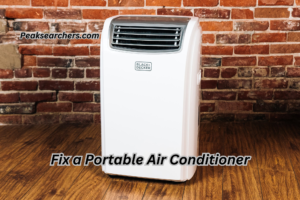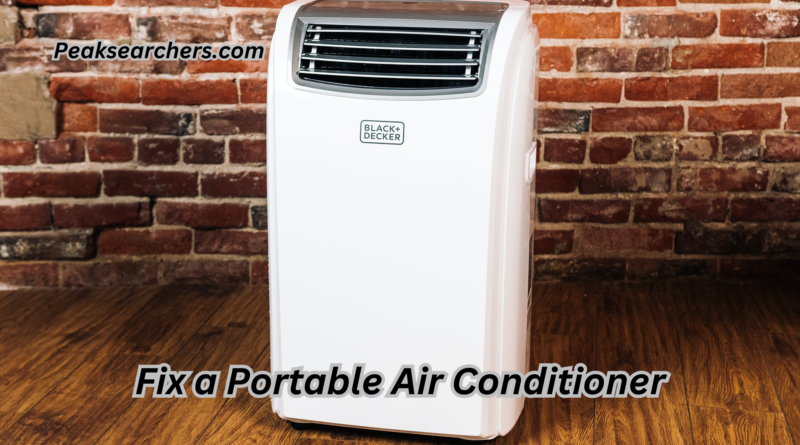How to Fix a Portable Air Conditioner? A Comprehensive Guide
Welcome to our comprehensive guide on How to Fix a Portable Air Conditioner. A Comprehensive Guide! If you’re experiencing issues with your portable AC unit, you’ve come to the right place.
In this article, we will provide you with a step-by-step walkthrough to troubleshoot and resolve common problems associated with portable air conditioners. When I got my new Portable Air Conditioner, I was not sure how to fix it when it was showing weird problems. Then, one of the professionals, who was my friend guided me and I was able to solve this issue.
Whether you’re dealing with cooling inefficiencies, strange noises, or other malfunctions, we’ve got you covered.

Understanding the Basics of Portable Air Conditioners
Before we delve into the troubleshooting process, let’s familiarize ourselves with the basic components and functioning of a portable air conditioner. By understanding how these units work, you’ll be better equipped to diagnose and fix any issues that may arise.
A portable air conditioner typically consists of the following components:
- Compressor: This is the heart of the air conditioner, responsible for compressing refrigerant gas and facilitating the cooling process.
- Condenser: The condenser releases heat from the refrigerant and converts it back into a liquid state.
- Evaporator: As the refrigerant evaporates, it absorbs heat from the surrounding air, resulting in cooler air being released into the room.
- Fan: The fan circulates air over the evaporator, helping to distribute the cooled air throughout the space.
- Exhaust Hose: This hose carries hot air from the unit to the outside, allowing for efficient cooling.
Troubleshooting Common Portable Air Conditioner Issues
Issue 1: Insufficient Cooling
If your portable air conditioner isn’t cooling the room effectively, follow these steps to troubleshoot the problem:
- Check the Filter: A clogged or dirty air filter can hinder airflow. Remove the filter, clean it according to the manufacturer’s instructions, and reinstall it.
- Inspect the Exhaust Hose: Ensure that the exhaust hose is securely connected to both the unit and the window vent. Any leaks or blockages can reduce the cooling efficiency.
- Verify the Temperature Settings: Make sure the temperature setting on the unit is lower than the room temperature. Adjust as needed.
- Avoid Heat Sources: Keep the unit away from heat-emitting appliances or direct sunlight, as this can affect its performance.
- Consider Room Size: Portable air conditioners have limitations regarding the size of the space they can effectively cool. Ensure your unit is suitable for the room’s dimensions.
Issue 2: Noisy Operation
If your portable air conditioner is making unusual noises, use the following steps to troubleshoot the issue:
- Inspect the Fan: Ensure there are no obstructions near or within the fan blades. Clear away any debris that may be causing the noise.
- Check for Loose Parts: Examine the unit for any loose screws, panels, or vents. Tighten or secure them as necessary.
- Level the Unit: A portable air conditioner should be placed on a level surface to prevent excessive vibrations. Adjust the positioning if needed.
- Consider Noise Reduction Methods: If the noise persists, you can use noise-absorbing materials or consider placing the unit on a rubber mat to reduce vibrations.
Issue 3: Water Leakage
Water leakage from a portable air conditioner can be a cause for concern. Follow these steps to address the issue:
- Empty the Drain Pan: Ensure the drain pan is not full or overflowing. Empty it regularly to prevent water from leaking.
- Clean the Drainage System: If the drainage system is clogged, water may accumulate and lead to leakage. Clean the drain channels and tubes using a mixture of water and mild detergent.
- Check Window Sealing: Improper sealing around the window vent can allow warm, humid air to enter the room and cause condensation. Ensure that the window kit is properly installed and sealed to prevent leakage.
Issue 4: Unit Not Turning On
If your portable air conditioner is not powering on, try the following troubleshooting steps:
- Check Power Supply: Ensure that the unit is securely plugged into a functioning power outlet. Consider trying a different outlet or using a surge protector.
- Inspect the Control Panel: Check if the control panel displays any error codes or indicators. Consult the user manual for guidance on interpreting these codes.
- Reset the Unit: Some portable air conditioners have a reset button. Press it to reset the unit and see if it powers on.
- Verify the Timer Settings: Make sure that the unit’s timer settings are not preventing it from turning on. Adjust the timer settings accordingly.
Maintenance Tips to Keep Your Portable Air Conditioner in Top Shape
Regular maintenance can prolong the lifespan of your portable air conditioner and prevent potential issues. Here are some maintenance tips to keep in mind:
- Clean the Filter: Clean or replace the air filter regularly, following the manufacturer’s instructions. A dirty filter can obstruct airflow and reduce cooling efficiency.
- Clear the Exhaust Hose: Inspect the exhaust hose for any obstructions or blockages. Remove any debris or lint that may accumulate.
- Wipe Down the Unit: Use a soft cloth to wipe the exterior surfaces of the unit and remove dust or dirt. Avoid using harsh chemicals that could damage the unit.
- Schedule Professional Servicing: Consider scheduling annual maintenance by a qualified technician. They can inspect the internal components, clean the unit thoroughly, and address any potential issues.
Energy Efficiency Tips for Portable Air Conditioners
In addition to troubleshooting and maintenance, optimizing the energy efficiency of your portable air conditioner can help you save on electricity bills. Consider the following tips:
- Set the Temperature Wisely: Avoid setting the temperature lower than necessary. Each degree lower increases energy consumption. Aim for a comfortable temperature rather than an excessively cool one.
- Utilize Timer and Sleep Modes: Take advantage of the timer and sleep modes offered by your unit. These features allow you to schedule cooling periods and adjust settings for energy-saving operations during nighttime.
- Consider Zone Cooling: Instead of cooling the entire house, focus on the rooms you frequently use. Close doors and vents in unoccupied rooms to direct the cool air where it’s needed most.
- Improve Insulation: Properly insulating your room can minimize heat exchange with the outside environment. Seal any gaps around windows, doors, and vents to prevent cool air from escaping and hot air from entering.
- Utilize Fans: Supplement the cooling effect of your portable air conditioner by using fans to help circulate cool air throughout the room. This allows you to set the AC to a slightly higher temperature while still enjoying a comfortable environment.
Choosing the Right Portable Air Conditioner
If you’re in the market for a new portable air conditioner or considering an upgrade, it’s important to choose the right unit for your needs. Here are a few factors to consider:
- BTU (British Thermal Units): The cooling capacity of a portable air conditioner is measured in BTUs. Calculate the appropriate BTU rating based on the size of the room you want to cool. A higher BTU is required for larger spaces.
- Energy Efficiency Ratio (EER): Look for units with higher EER ratings. A higher EER indicates greater energy efficiency and lower operating costs.
- Noise Levels: Check the noise rating of the unit before purchasing, especially if you plan to use it in a bedroom or office space where quiet operation is important.
- Portability and Design: Consider the size, weight, and maneuverability of the unit. Look for features such as caster wheels and handles for easy transportation. Additionally, choose a design that complements your room’s aesthetics.
- Additional Features: Some portable air conditioners come with additional features such as programmable timers, remote controls, and advanced air filtration systems. Assess your preferences and prioritize the features that are important to you.
Also Read: How To Clean Portable Air Conditioner Water Tank? A Comprehensive Guide
FAQ’s
How do you fix a portable air conditioner that is not cooling?
To fix a portable air conditioner that is not cooling:
- Check the temperature settings and adjust them if needed.
- Clean or replace the air filter to ensure proper airflow.
- Verify that the exhaust hose is securely connected and free from obstructions.
- Clean the condenser coils to improve heat release.
- Seal the window vent to prevent warm air from entering.
- Keep the unit away from heat sources and direct sunlight.
- Ensure the unit’s cooling capacity matches the room size.
- Place the unit on a level surface for optimal operation.
- Provide adequate space for air circulation around the unit.
Why is my air conditioner running but not cooling?
If your air conditioner is running but not cooling, consider these potential causes and solutions:
- Dirty Air Filter: Clean or replace the air filter to improve airflow.
- Refrigerant Leak: Contact a professional to repair leaks and recharge the system.
- Frozen Evaporator Coil: Allow the coil to thaw and check for airflow restrictions. Consult a technician if the issue persists.
- Faulty Condenser Unit: Clear debris from the unit or seek professional assistance.
- Improper Sizing: Consult an HVAC professional to determine the correct size for your space.
- Electrical Issues: Check connections, reset breakers, and ensure the thermostat functions properly.
If problems persist, contact an HVAC technician for further assistance.
How to reset a portable air conditioner?
To reset or fix a portable air conditioner, follow these general steps:
- Turn Off the Unit: Ensure that the portable air conditioner is switched off and unplugged from the power source.
- Wait for a Few Minutes: Allow the unit to remain unplugged for approximately 5-10 minutes. This waiting period helps to reset the internal components and electronics.
- Plug In and Turn On: After the waiting period, plug the unit back into the power source.
- Reset the Control Panel: Locate the control panel or display on the unit. Look for a reset button or an option to reset the settings. Press and hold the reset button or follow the instructions in the user manual to perform a reset.
- Wait for the Unit to Restart: Once the reset is initiated, wait for the unit to restart. This process may take a few seconds or a couple of minutes, depending on the model.
- Set Preferences: After the unit has restarted, adjust the settings according to your preferences. Set the desired temperature, fan speed, and mode of operation.
Portable air conditioner recharge kit?
Recharge kits for portable air conditioners are not typically available or recommended for consumer use. These units are pre-charged during manufacturing and do not require recharging.
If your portable air conditioner is not cooling effectively, it is best to consult a professional HVAC technician or the manufacturer’s customer support for assistance. They have the expertise to diagnose and address any issues with the refrigerant system.
Attempting to recharge the unit yourself can be dangerous and may void the warranty. Always follow the manufacturer’s guidelines and seek professional help for any necessary repairs.
Conclusion
By following the troubleshooting steps and maintenance tips outlined in this comprehensive guide, you can effectively address common problems with your portable air conditioner especially “fix a portable AC”. Remember to refer to the user manual provided by the manufacturer for specific instructions tailored to your unit.
Ensure that you take necessary precautions while troubleshooting or performing maintenance tasks, and if you encounter complex issues or require professional assistance, don’t hesitate to reach out to a certified technician. Keeping your portable air conditioner in optimal condition will ensure that you enjoy cool and comfortable air for years to come.


